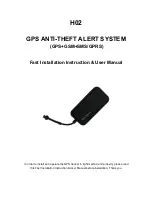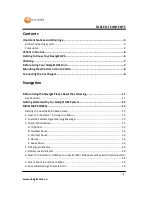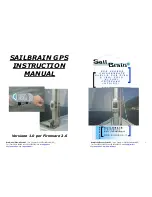
that require navigation through a narrow waterway (
).
Adjusting the Distance from Shore
The Shoreline Distance setting indicates how close to the shore
you want the Auto Guidance line to be placed. The Auto
Guidance line may move if you change this setting while
navigating. The available values for the Shoreline Distance
setting are relative, not absolute. To ensure the Auto Guidance
line is placed the appropriate distance from shore, you can
assess the placement of the Auto Guidance line using one or
more familiar destinations that require navigation through a
narrow waterway.
1
Dock your vessel or drop the anchor.
2
Select
Settings
>
Preferences
>
Navigation
>
Auto
Guidance
>
Shoreline Distance
>
Normal
.
3
Select a destination that you have navigated to previously.
4
Select
Navigate To
>
Auto Guidance
.
5
Review the placement of the Auto Guidance line, and
determine whether the line safely avoids known obstacles
and the turns enable efficient travel.
6
Select an option:
• If the placement of the Auto Guidance line is satisfactory,
select
Menu
>
Navigation Options
>
Stop Navigation
,
and proceed to step 10.
• If the Auto Guidance line is too close to known obstacles,
select
Settings
>
Preferences
>
Navigation
>
Auto
Guidance
>
Shoreline Distance
>
Far
.
• If the turns in the Auto Guidance line are too wide, select
Settings
>
Preferences
>
Navigation
>
Auto Guidance
>
Shoreline Distance
>
Near
.
7
If you selected
Near
or
Far
in step 6, review the placement of
the Auto Guidance line, and determine whether the line
safely avoids known obstacles and the turns enable efficient
travel.
Auto Guidance maintains a wide clearance from obstacles in
open water, even if you set the Shoreline Distance setting to
Near or Nearest. As a result, the chartplotter may not
reposition the Auto Guidance line, unless the destination
selected requires navigation through a narrow waterway.
8
Select an option:
• If the placement of the Auto Guidance line is satisfactory,
select
Menu
>
Navigation Options
>
Stop Navigation
,
and proceed to step 10.
• If the Auto Guidance line is too close to known obstacles,
select
Settings
>
Preferences
>
Navigation
>
Auto
Guidance
>
Shoreline Distance
>
Farthest
.
• If the turns in the Auto Guidance line are too wide, select
Settings
>
Preferences
>
Navigation
>
Auto Guidance
>
Shoreline Distance
>
Nearest
.
9
If you selected
Nearest
or
Farthest
in step 8, review the
placement of the
Auto Guidance
line, and determine
whether the line safely avoids known obstacles and the turns
enable efficient travel.
Auto Guidance maintains a wide clearance from obstacles in
open water, even if you set the Shoreline Distance setting to
Near or Nearest. As a result, the chartplotter may not
reposition the Auto Guidance line, unless the destination
selected requires navigation through a narrow waterway.
10
Repeat steps 3 through 9 at least once more, using a
different destination each time, until you are familiar with the
functionality of the Shoreline Distance setting.
Tracks
A track is a recording of the path of your boat. The track
currently being recorded is called the active track, and it can be
saved. You can show tracks in each chart or 3D chart view.
Showing Tracks
1
From a chart, select
Menu
>
Layers
>
User Data
>
Tracks
.
2
Select the tracks to display.
A trailing line on the chart indicates your track.
Setting the Color of the Active Track
1
Select
Info
>
User Data
>
Tracks
>
Active Track Options
>
Track Color
.
2
Select a track color.
Saving the Active Track
The track currently being recorded is called the active track.
1
Select
Info
>
User Data
>
Tracks
>
Save Active Track
.
2
Select an option:
• Select the time the active track began.
• Select
Entire Log
.
3
Select
Save
.
Viewing a List of Saved Tracks
Select
Info
>
User Data
>
Tracks
>
Saved Tracks
.
Editing a Saved Track
1
Select
Info
>
User Data
>
Tracks
>
Saved Tracks
.
2
Select a track.
3
Select
Edit Track
.
4
Select an option:
• Select
Name
, and enter the new name.
• Select
Track Color
, and select a color.
Saving a Track as a Route
1
Select
Info
>
User Data
>
Tracks
>
Saved Tracks
.
2
Select a track.
3
Select
Select
>
Edit Track
>
Save Route
.
Browsing for and Navigating a Recorded Track
Before you can browse a list of tracks and navigate to them, you
must record and save at least one track (
1
Select
Info
>
User Data
>
Tracks
>
Saved Tracks
.
2
Select a track.
3
Select
Follow Track
.
4
Select an option:
• To navigate the track from the starting point used when
the track was created, select
Forward
.
• To navigate the track from the destination point used
when the track was created, select
Backward
.
5
Review the course indicated by the colored line.
6
Follow the line along each leg in the route, steering to avoid
land, shallow water, and other obstacles.
Deleting a Saved Track
1
Select
Info
>
User Data
>
Tracks
>
Saved Tracks
.
2
Select a track.
3
Select
Select
>
Delete
.
Deleting All Saved Tracks
Select
Info
>
User Data
>
Delete User Data
>
Saved
Tracks
.
Retracing the Active Track
The track currently being recorded is called the active track.
Navigation with a Chartplotter
19
Summary of Contents for GPSMAP A12
Page 1: ...GPSMAP A12 Owner sManual...
Page 8: ......
Page 73: ......
Page 74: ...support garmin com December 2018 190 02262 00_0D...
















































